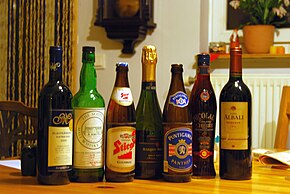
Back Bebida alcolica AN مشروب كحولي Arabic تصنيف:مشروبات د لكوحول ARY خمور ARZ Bébora alcohólico AST Alkoqollu içkilər Azerbaijani Alkoholėnis gėrėms BAT-SMG Алкагольныя напоі Byelorussian Сьпіртовы напой BE-X-OLD Aèr serani BEW


Drinks containing alcohol are typically divided into three classes—beers, wines, and spirits—with alcohol content typically between 3% and 50%. Drinks with less than 0.5% are sometimes considered non-alcoholic.
Many societies have a distinct drinking culture, where alcoholic drinks are integrated into parties. Most countries have laws regulating the production, sale, and consumption of alcoholic beverages.[1] Some regulations require the labeling of the percentage alcohol content (as ABV or proof) and the use of a warning label. Some countries ban the consumption of alcoholic drinks, but they are legal in most parts of the world. The temperance movement advocates against the consumption of alcoholic beverages.[2] The global alcoholic drink industry exceeded $1.5 trillion in 2017.[3] Alcohol is one of the most widely used recreational drugs in the world, and about 33% of all humans currently drink alcohol.[4] In 2015, among Americans, 86% of adults had consumed alcohol at some point, with 70% drinking it in the last year and 56% in the last month.[5] Several other animals are affected by alcohol similarly to humans and, once they consume it, will consume it again if given the opportunity, though humans are the only species known to produce alcoholic drinks intentionally.[6]
Alcohol is a depressant, which in low doses causes euphoria, reduces anxiety, and increases sociability. In higher doses, it causes drunkenness, stupor, unconsciousness, or death. Long-term use can lead to alcoholism, an increased risk of developing several types of cancer, cardiovascular disease, and physical dependence.
Alcohol is classified as a group 1 carcinogen. In 2023, the World Health Organization declared that 'the risk to the drinker's health starts from the first drop of any alcoholic beverage.'[7]
- ^ "Minimum Legal Age Limits". IARD.org. International Alliance for Responsible Drinking. Archived from the original on 4 May 2016. Retrieved 23 June 2016.
- ^ Henry, Yeomans (18 June 2014). Alcohol and Moral Regulation: Public Attitudes, Spirited Measures and Victorian Hangovers. Policy Press. p. 244. ISBN 978-1-4473-0994-9.
- ^ Cite error: The named reference
PMID32079559was invoked but never defined (see the help page). - ^ Griswold, Max G.; Fullman, Nancy; Hawley, Caitlin; Arian, Nicholas; Zimsen, Stephanie R M.; Tymeson, Hayley D.; Venkateswaran, Vidhya; Tapp, Austin Douglas; Forouzanfar, Mohammad H.; Salama, Joseph S.; Abate, Kalkidan Hassen; Abate, Degu; Abay, Solomon M.; Abbafati, Cristiana; Abdulkader, Rizwan Suliankatchi; Abebe, Zegeye; Aboyans, Victor; Abrar, Mohammed Mehdi; Acharya, Pawan; Adetokunboh, Olatunji O.; Adhikari, Tara Ballav; Adsuar, Jose C.; Afarideh, Mohsen; Agardh, Emilie Elisabet; Agarwal, Gina; Aghayan, Sargis Aghasi; Agrawal, Sutapa; Ahmed, Muktar Beshir; Akibu, Mohammed; et al. (August 2018). "Alcohol use and burden for 195 countries and territories, 1990–2016: a systematic analysis for the Global Burden of Disease Study 2016". The Lancet. 392 (10152): 1015–1035. doi:10.1016/S0140-6736(18)31310-2. ISSN 0140-6736. PMC 6148333. PMID 30146330.
- ^ "Alcohol Facts and Statistics". National Institute on Alcohol Abuse and Alcoholism. National Institute of Health. August 2018. Archived from the original on 18 May 2015. Retrieved 8 October 2018.
- ^ Zielinski, Sarah (16 September 2011). "The Alcoholics of the Animal World". Smithsonian. Archived from the original on 22 August 2015. Retrieved 29 July 2015.
- ^ "No level of alcohol consumption is safe for our health". World Health Organization. 4 January 2023.